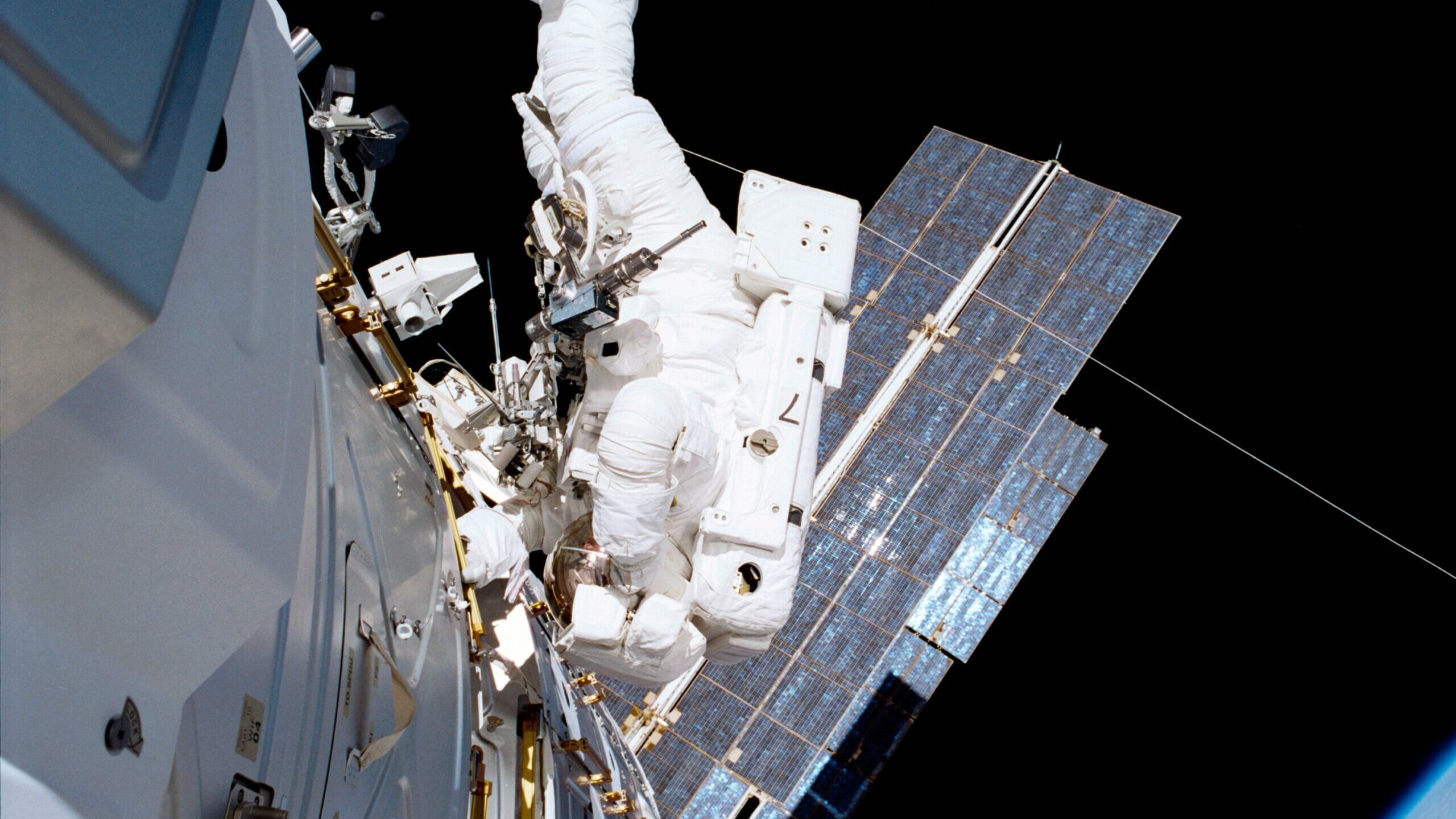
Mission Specialist (MS) Robert Curbeam works to remove sections of debris shielding on the U.S. Destiny Laboratory module in preparation for Power and Data Grappling Fixture (PDGF) connections. May 24, 2011. (NASA)
When Russia launched an anti-satellite test in mid-November, it created a debris field of at least 1,500 pieces of space junk that now serve as live threats to anything in orbit — everything from the International Space Station to key military satellites. It’s a long-held concern for space experts, brought to life. In a new op ed, Joshua Humnisky says it’s time for the Pentagon to support a real push towards global norms that will rein in the threat.
Russia’s recent anti-satellite weapons test created two parallel, but seemingly contradictory policy opportunities for the United States Space Force: supporting the establishment of an international moratorium on peacetime debris-creating events, while simultaneously developing the capability to rapidly replace lost or damaged assets through diversified launch.
The Russian direct ascent anti-satellite (DA-ASAT) weapons test created upwards of 1,500 unique pieces of trackable debris, to say nothing of pieces too small to be tracked yet still dangerous to both the International Space Station and existing satellite constellations. The threat of this debris, as with other tests by China and India, will last for years, if not decades.
Why Russia decided to conduct the test now is an open question, but the reality is that the test itself highlights multiple growing problems in space, not the least of which is the increasing debris field that is surrounding the globe. According to NASA, there are at least 100 million pieces of space debris, with the Department of Defense tracking over 27,000 large pieces (10cm or larger) in orbit. Even if humans were to stop traveling to space or putting satellites in orbit, this debris would remain in space for generations to come. A simple truth: the last thing humanity needs is the creation of unnecessary space debris through events such as ASAT tests.
It is here that leaders in the Pentagon should support efforts to create international norms of behavior in space, in particular by supporting a moratorium on peace-time debris-creating events such as ASAT tests. Indeed, based on the recent National Space Council meeting it appears that the Biden Administration is preparing to outline new global norms for military space. Such a moratorium would not undo the damage done thus far, but it would help establish a convention on what responsible space actors can and should do in space when it comes to defense and security. Naturally, this type of norm is only subject to the parties’ agreement and commitment as there is no supra-national enforcement body, but violators would be known, and could be named and shamed.
Some may question the security and defense implications of such a moratorium. Wouldn’t we be tying our hands? This is a fair question, but it is equally one that is applicable to any norm of international behavior on defense or security. Other conventions, such as the Chemical Weapons Convention, exist and are, largely, followed. (Thankfully this has not been tested in inter-state warfare.)
Pursuing such a moratorium would demonstrate Washington’s international leadership and forethought, two critical elements needed in space now more than ever.
While a debris field may, on its surface, make sense as a way to counter another nation’s space assets, space junk does not differentiate if it’s a Chinee or American system it destroys. In a conflict, creating a Kessler Syndrome debris cascade in space could do Beijing or Moscow as much harm as it does Washington, particularly as both nations increase their reliance on space-based communications, early warning, and intelligence, surveillance, and reconnaissance.
Moreover, there are other ways of denying Russia, China, Iran, or other actors the ability to operate in and from space—ones that do not necessitate debris-creating weapons. Indeed, Gen. David “DT” Thompson said as much on the sidelines of the recent Halifax International Security Forum, warning that the Space Force is dealing with “reversible attacks…every single day,” such as cyber intrusions or electronic jamming.
Concurrently, Russia’s test also highlights the importance of changing the national security space establishment’s way of thinking when developing launch capabilities, to include the next phase of the National Security Space Launch (NSSL) program. This will necessitate augmenting the already successful and performing NSSL to incorporate novel capabilities such as small launch and air launch to on-orbit stationing of next-generation satellites and platforms. The service must look at the panoply of launch, including multiple, diverse launch sites, in order to ensure that in the event an asset is lost, it can be swiftly replaced from any one of the multiple sites.
It is confidence-inspiring that the Space Force and Space Systems Command are starting to adopt this way of thinking, but it must accelerate—and fast. This means changing the contracting cycle and process to match the speed of innovation with the speed of acquisition.
No one wins if earth’s orbital backyard becomes a junkyard. The more debris that is created and left orbiting, the greater the risk that something invaluable gets hit and jeopardizes the way we live and work. Russia’s ASAT test presents opportunities for the Space Force to demonstrate its thought leadership while ensuring the security and defense of the United States. Never let an opportunity go to waste, and here is one offered up by Moscow’s challenge that the Guardians should gladly accept.
Joshua C. Huminski is Director of the National Security Space Program at the Center for the Study of the Presidency & Congress, and a George Mason University National Security Institute Visiting Fellow. He can be found on Twitter @joshuachuminski.
Airbus, UK agree $152 million deal for 6 H145 ‘overseas’ helicopters
The fleet of light-twin rotorcraft will replace Airbus Puma HC2 types, which have been temporarily based in Brunei for British Army training and the island of Cyprus in support of Royal Air Force search and rescue missions.


























